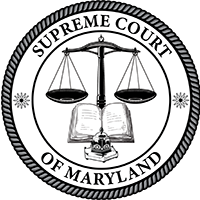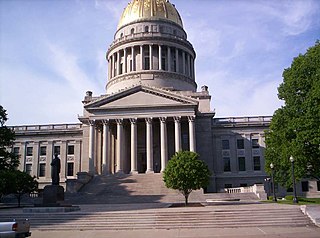In the United States, a state supreme court is the highest court in the state judiciary of a U.S. state. On matters of state law, the judgment of a state supreme court is considered final and binding in both state and federal courts.
The government of the U.S. state of Missouri is organized into the state government and local government, including county government, and city and municipal government.
Circuit courts are court systems in several common law jurisdictions. It may refer to:

The Supreme Court of Maryland is the highest court of the U.S. state of Maryland. The court, which is composed of one chief justice and six associate justices, meets in the Robert C. Murphy Courts of Appeal Building in the state capital, Annapolis. The term of the Court begins the second Monday of September. The Court is unique among American courts in that the justices wear red robes.

The government of Maryland is conducted according to the Maryland Constitution. The United States is a federation; consequently, the government of Maryland, like the other 49 state governments, has exclusive authority over matters that lie entirely within the state's borders, except as limited by the Constitution of the United States.
The structure of the judiciary of Texas is laid out in Article 5 of the Constitution of Texas and is further defined by statute, in particular the Texas Government Code and Texas Probate Code. The structure is complex, featuring many layers of courts, numerous instances of overlapping jurisdiction, several differences between counties, as well as an unusual bifurcated appellate system at the top level found in only one other state: Oklahoma. Municipal Courts are the most active courts, with County Courts and District Courts handling most other cases and often sharing the same courthouse.
The Supreme Court of Appeals of West Virginia is the state supreme court of the state of West Virginia, the highest of West Virginia's state courts. The court sits primarily at the West Virginia State Capitol in Charleston, although from 1873 to 1915, it was also required by state law to hold sessions in Charles Town in the state's Eastern Panhandle. The court also holds special sittings at various locations across the state.

West Virginia's 1st congressional district is currently located in the southern half of the state.
The Superior Court is the state court in the U.S. state of New Jersey, with statewide trial and appellate jurisdiction. The New Jersey Constitution of 1947 establishes the power of the New Jersey courts. Under the State Constitution, "'judicial power shall be vested in a Supreme Court, a Superior Court, County Courts and inferior courts of limited jurisdiction.'" The Superior Court has three divisions: the Appellate Division is essentially an intermediate appellate court while the Law and Chancery Divisions function as trial courts. The State Constitution renders the New Jersey Superior Court, Appellate Division the intermediate appellate court, and "[a]ppeals may be taken to the Appellate Division of the Superior Court from the law and chancery divisions of the Superior Court and in such other causes as may be provided by law." Each division is in turn divided into various parts. "The trial divisions of the Superior Court are the principal trial courts of New Jersey. They are located within the State's various judicial geographic units, called 'vicinages,' R. 1:33-2(a), and are organized into two basic divisions: the Chancery Division and the Law Division".

The Appellate Court of Maryland is the intermediate appellate court for the U.S. state of Maryland. The Appellate Court of Maryland was created in 1966 in response to the rapidly growing caseload in the Supreme Court of Maryland. Like the state's highest court, the tribunal meets in the Robert C. Murphy Courts of Appeal Building in the state capital, Annapolis.

The Oklahoma Court of Criminal Appeals is one of the two highest judicial bodies in the U.S. state of Oklahoma and is part of the Oklahoma Court System, the judicial branch of the Oklahoma state government.

The United States District Court for the Southern District of West Virginia is a federal court in the Fourth Circuit.

The Government of West Virginia is modeled after the Government of the United States, with three branches: the executive, consisting of the Governor of West Virginia and the other elected constitutional officers; the legislative, consisting of the West Virginia Legislature which includes the Senate and the House of Delegates; and the judicial, consisting of the West Virginia Supreme Court of Appeals and lower courts.

The Alabama Circuit Courts are the state trial courts of general jurisdiction in the State of Alabama. The Circuit Courts have jurisdiction to hear civil and criminal cases. For civil cases, the courts has authority to try cases with an amount in controversy of more than $3,000 and has exclusive original jurisdiction over claims for more than $10,000. The Circuit Courts are the criminal trial courts for most felony charges, and for some misdemeanors and lesser included offenses. The Circuit Courts also have appellate jurisdiction over certain cases arising from the Alabama District Courts.
United States v. More, 7 U.S. 159 (1805), was a United States Supreme Court case in which the Court held that it had no jurisdiction to hear appeals from criminal cases in the circuit courts by writs of error. Relying on the Exceptions Clause, More held that Congress's enumerated grants of appellate jurisdiction to the Court operated as an exercise of Congress's power to eliminate all other forms of appellate jurisdiction.
In West Virginia, magistrate courts are non-lawyer small claims and petty crime courts, established to replace the justice of the peace system in 1976. There are at least two magistrates in every county, and ten in the largest county, Kanawha. Magistrates have jurisdiction over civil cases in which the financial amount in dispute is less than ten thousand dollars. They hear misdemeanor cases and conduct preliminary examinations in felony cases. In criminal cases they issue and record affidavits, complaints, arrest warrants, and search warrants, as well as set bail and make decisions concerning proposed plea agreements, the collection of courts costs, cash bonds, and fines. Magistrates issue emergency protective orders in cases involving domestic violence.
The judiciary of Illinois is the unified court system of Illinois responsible for applying the Constitution and law of Illinois. It consists of the Supreme Court, the Appellate Court, and circuit courts. The Supreme Court oversees the administration of the court system.
The judiciary of Michigan is defined under the Michigan Constitution, law, and regulations as part of the Government of Michigan. The court system consists of the Michigan Supreme Court, the Michigan Court of Appeals as the intermediate appellate court, the circuit courts and district courts as the two primary trial courts, and several administrative courts and specialized courts. The Supreme Court administers all the courts. The Michigan Supreme Court consists of seven members who are elected on non-partisan ballots for staggered eight-year terms, while state appellate court judges are elected to terms of six years and vacancies are filled by an appointment by the governor, and circuit court and district court judges are elected to terms of six years.
The Intermediate Court of Appeals of West Virginia is the intermediate appellate court in West Virginia, created pursuant to the West Virginia Appellate Reorganization Act of 2021.








